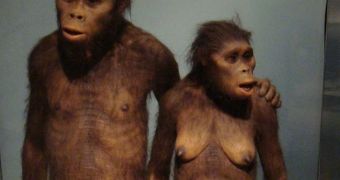According to a new finding, it would appear that ancient hominins had an upright gait more than 2 million years earlier than experts previously estimated. This conclusion is based on an analysis of a famous trail containing ancient footprints made by some of our most distant ancestors.
At that time, hominins were not exclusively bipedal. The team behind the new study discovered that the individuals who made the tracks most likely spent the vast majority of their time climbing trees.
Yet, when they touched land, they walked upright, in very much the same way a modern human does. Granted, there are differences in gait, that occurred over millions of years of evolution. We tend to conserve our energy more efficiency while walking than they ever could.
Experts found the trail that revealed these data in Tanzania, East Africa. Dating techniques put the age of the fossilized site – which has since been dubbed the Laetoli trail – at around 3.5 million years.
Apparently, the ancient hominins were walking through fresh volcanic ash. A soft rain may have fallen from above at that time, solidifying the tracks, and allowing them to remain preserved until they were discovered again, back in 1976, LiveScience reports.
“A few people argue that the Laetoli prints were created in an ape-like way. Our findings are very different. They support the opposite interpretation that they are very modern footprints in many respects,” says Robin Crompton, PhD.
The expert, a researcher on the new study, holds an appointment as a professor with the Department of Musculoskeletal Biology at the University of Liverpool, in the United Kingdom. He and his team conducted precise digital scans of all available tracks.
With patience, the team then analyzed the scans, finding the points where the ancient hominins had placed the largest force while moving. These areas vary from species to species, and can be used as indicators as to how our distant ancestors walked like.
Experts then compared the readings with similar scans, of tracks made by city dwellers, indigenous people, and bonobos and chimpanzees that walked upright. Their goal was to determine whether the gait of these modern creatures could be traced so far back.
“These [Laetoli] footprints are quite definitely well within the modern human range, I'm sure of that. This is a very early date for human-like walking,” Crompton says. The scans seem to indicate that the hominins used their big toes to push down on the ground.
Great apes today use their mid-foot to push on the ground, but our species doesn't. This means that a clear connection can be drawn over the ages. “These hominins used human-like walking on the ground but were still capable of using resources in the trees,” explains expert David Raichlen.
“However, this study does support the idea that some of the adaptations for climbing we see in the feet of other apes were not present in Laetoli hominins,” he adds. The expert holds an appointment as a researcher at the University of Arizona, but was not a part of the new work.

 14 DAY TRIAL //
14 DAY TRIAL //